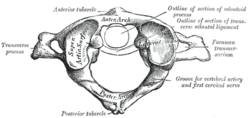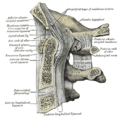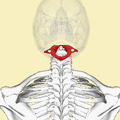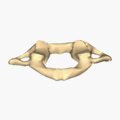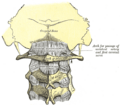Atlas (anatomy) facts for kids
| Bone: Atlas (anatomy) | ||
|---|---|---|
| First cervical vertebra, or Atlas | ||
The atlas is a special bone in your neck. It is the very first bone at the top of your spine. This bone is also called the C1 vertebra. It is named after Atlas, a giant from Greek myths. He was said to hold the sky on his shoulders. Just like Atlas, this bone holds up your head.
The atlas works closely with another neck bone called the axis. The axis is the second bone in your neck, also known as C2. Together, the atlas and axis form a unique joint. This joint connects your skull to the rest of your spine.
These two bones are different from other spine bones. They allow your head to move in many ways. You can nod your head up and down. You can also turn your head from side to side. This movement is very important for daily activities.
Contents
What is the Atlas Bone?
The atlas bone is the first of seven bones in your neck. These neck bones are called cervical vertebrae. The atlas is shaped like a ring. It does not have a body like other vertebrae. Instead, it has two arches and two bony masses. These features help it connect to the skull and the axis.
How the Atlas Connects
The top part of the atlas connects to the base of your skull. This connection allows your head to nod. Think of it like saying "yes." The bottom part of the atlas connects to the axis bone. The axis has a special peg-like part. This part fits into the atlas. This connection lets your head rotate. This is how you shake your head "no."
Why the Atlas is Important
The atlas bone is very important for several reasons.
- It supports the weight of your head.
- It protects your spinal cord. The spinal cord is a bundle of nerves. It runs through the middle of your spine.
- It allows for a wide range of head movements. These movements are needed for seeing and hearing.
Images for kids
-
Structure of the atlas, the first cervical vertebra
See also
 In Spanish: Atlas (hueso) para niños
In Spanish: Atlas (hueso) para niños


